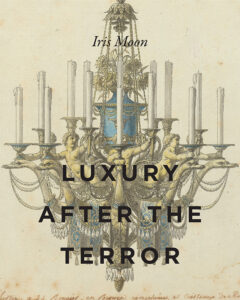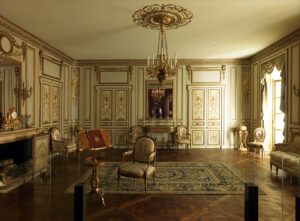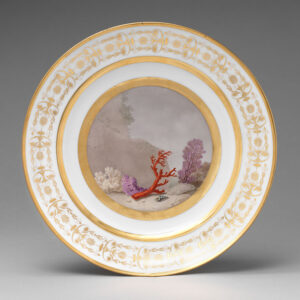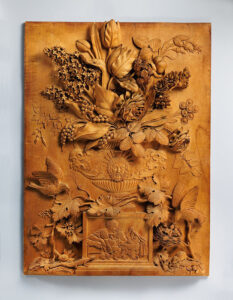New Book Explores Luxury after the Terror
by Iris Moon
Luxury After the Terror explores the production, circulation, and survival of French luxury after the death of Louis XVI by focusing on decorative arts makers with strong ties to the monarchy and how they navigated the Terror and the world that it remade. Published by Penn State University Press in April 2022 with the generous support of a Dean F. Failey Grant from the Decorative Arts Trust, the book looks at objects fashioned from gold, silk, wood, and porcelain, and the new meanings they accumulated during this turbulent period.
When Louis XVI was guillotined on January 21, 1793, the king’s death was to mark the physical end of the monarchy in France by severing the vast networks of luxury that had provided splendor and sophistication to the royal court and constituted the source of its cultural legitimacy. Yet the remnants of the royal collection that were sold, circulated, and absorbed by the French state’s new institutions signaled neither a complete rupture with the past nor the total transfer of cultural authority to the body politic. Even as the king’s royal possessions—from drapery and tableware to clocks and porcelain services—were dispersed or destroyed, many of the individuals responsible for creating these forms of material finery found ways to survive regime change and forge new meanings for their work in the rapidly shifting circumstances of revolutionary France and its aftermath.
The starting point for this book began in the 18th-century period rooms at The Metropolitan Museum of Art. The series of wainscoted rooms in the Wrightsman Galleries for the French Decorative Arts are fantasy worlds intended to evoke the lost splendor of the ancien régime, which lavished care and attention on everything from soft-paste porcelain coffee cups to paper-thin goblets and silver tableware, down to the carved and gilded scroll of a hand-made chair (figure 1). Within the dimly lit galleries, I puzzled over how luxury objects so inimical to the political objectives of the French Revolution had managed to survive that period, despite their close associations with the court of Louis XVI and his wife Marie-Antoinette, who was guillotined after her husband on October 16, 1793. Dispersal, I realized, had shaped the historical trajectories of so many of the museum’s objects, in equally important ways as commissions and collections. Where did such things, with their uneasy associations with the privileged world of the monarchy and aristocracy, go during the Revolution, and how did they end up in the museum? How did those who made luxury survive the Terror?
The book begins with the dispersal of the royal collections at the Palace of Versailles that began in 1793 after the death of the king. Organized by the government to finance its increasingly expensive military campaigns, everything from the royal bedsheets and linens to the wines that had been located in the “cave Capet’’ were sold to the highest bidder. Alongside the unexpected paths of the luxury objects formerly in the royal collections, the four subsequent chapters explore artists working in porcelain, gold, wood, and silk, and how the revolution took them on unpredictable journeys. The four protagonists, joined by their ties to the French luxury industry, present different aspects of what remained of the complicated realm of production that unraveled as the ancien régime world of the wealthy, the privileged, and the elite came undone and was remade by the politically uncertain circumstances of the French Revolution. I wanted to focus on the makers of luxury, such as the Dihl et Guérhard porcelain factory (figure 2), rather than patrons, because I wanted to understand the interpretation of the works they made, manufactured, designed, and sold from their perspective. Moreover, I wanted to show how the trajectories of forgotten decorative arts makers were quite different from the stories of painters like Jacques-Louis David, whose work still dominates the art histories of the French Revolution.
At a time when it was politically dangerous to remember the king, wood carving provided an alternative language of remembrance in contrast to the revolutionary prints that flooded the streets and to the stark ideological paintings that dominated the French salon. Although wood carver Aubert-Henri-Joseph Parent was not in the immediate circle of royal court artists, he identified strongly with the monarchy. Going into exile in 1794, Parent carved an unusual portrait of the king in a medallion hovering over his tomb (figure 3), a tomb that was fictional since the king’s body had been swiftly buried in a mass grave at the Madeleine cemetery and covered with quicklime, so that no one could find his remains. One can make out the faint traces of the Bourbon fleur-de-lys, lightly carved and only detectable by close examination. Through this book, I hope that readers of all different backgrounds and interests will find new stories of luxury during the French Revolution. I am grateful to the generosity of the Decorative Arts Trust, and look forward to advancing the importance of the decorative arts and their fascinating histories through this publication.
Iris Moon is Assistant Curator in the European Sculpture and Decorative Arts Department at The Metropolitan Museum of Art. Learn more in The Decorative Arts Trust Bulletin.
A print version of this article was published in The Magazine of the Decorative Arts Trust, one of our most popular member benefits. Join today!




